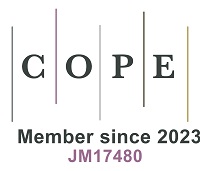REFERENCES
1. Acheampong, A. O.; Boateng, E.; Annor, C. B. Do corruption, income inequality and redistribution hasten transition towards (non)renewable energy economy? Struct. Chang. Econ. Dyn. 2024, 68, 329-54.
2. Feng, Y.; Yan, Y.; Shi, K.; Zhang, Z. Reducing carbon emission at the corporate level: Does artificial intelligence matter? Environ. Impact. Assess. Rev. 2025, 114, 107911.
4. Grossman, G. M.; Krueger, A. B. Economic growth and the environment. Q. J. Econ. 1995, 110, 353-77.
6. Aslanidis, N. Environmental kuznets curves for carbon emissions: a critical survey. SSRN. Electron. J. 2009.
8. Grossman, G. M.; Krueger, A. B. Environmental impacts of a North American free trade agreement. Cambridge, MA: National Bureau of Economic Research; 1991.
9. Panayotou, T. Empirical tests and policy analysis of environmental degradation at different stages of economic development. WEP; 1993. Available from: https://d1wqtxts1xzle7.cloudfront.net/79436985/93B09_31_engl-libre.pdf?1642973134=&response-content-disposition=inline%3B+filename%3DEmpirical_tests_and_policy_analysis_of_e.pdf&Expires=1761335891&Signature=QDLEFQiEZk-hmVFAlrA5mKVGAXCtkm7s8QVYRWSTLxi7Obh9WhxNkMB0imort2nvXc36QbleIUB0hB6mkq8cdl9L47snqaJTXn0G-VLBm145JZLn5HnEpe0W1cPn-m-19cLXydyWYZP0uAiylfASQLkvkx2iJyn2741Sungv1xtY9aLzIYiLs~L-6ep8aG2agbIFOu3VBzXdHz-oPauPZ~-yzdt1C4hv8dSWp~jxFds4LC~G8JlZYSSuvGsCFFtTs0ZdfnPJQ8DU2HGwDusbSUOzOrkslAiiMIXOGMUyEg1N5CJhdy7Honpz6Mx7zjktt78iHMF4TsH678BtlZnrOQ__&Key-Pair-Id=APKAJLOHF5GGSLRBV4ZA [Last accessed on 28 Oct 2025].
10. Yao, S.; Zhang, S.; Zhang, X. Renewable energy, carbon emission and economic growth: a revised environmental Kuznets Curve perspective. J. Clean. Prod. 2019, 235, 1338-52.
11. Oliveira, H.; Moutinho, V. Renewable energy, economic growth and economic development nexus: a bibliometric analysis. Energies 2021, 14, 4578.
12. Nabaweesi, J.; Kigongo, T. K.; Buyinza, F.; Adaramola, M. S.; Namagembe, S.; Nkote, I. N. Investigating the modern renewable energy-environmental Kuznets curve (REKC) hypothesis for East Africa Community (EAC) countries. Technol. Sustain. 2024, 3, 76-95.
13. Pata, U. K.; Bulut, U.; Balsalobre-Lorente, D.; Chovancová, J. Does income growth affect renewable energy or carbon emissions first? A Fourier-based analysis for renewable and fossil energies. Energy. Strategy. Rev. 2025, 57, 101615.
14. bp. The Statistical Review of World Energy analyses data on world energy markets from the prior year. The Review has been providing timely, comprehensive and objective data to the energy community since 1952. Available from: https://www.bp.com/content/dam/bp/business-sites/en/global/corporate/pdfs/energy-economics/statistical-review/bp-stats-review-2022-full-report.pdf [Last accessed on 25 Oct 2025].
15. Adebayo, T. S.; Sevinç, H.; Sevinç, D. E.; Ojekemi, O. S.; Kirikkaleli, D. A wavelet-based model of trade openness with ecological footprint in the MINT economies. Energy. Environ. 2024, 35, 2178-97.
16. Abdullahi, N. M.; Ibrahim, A. A.; Zhang, Q.; Huo, X. Dynamic linkages between financial development, economic growth, urbanization, trade openness, and ecological footprint: an empirical account of ECOWAS countries. Environ. Dev. Sustain. 2025, 27, 25103-30.
17. Zhou, D.; Kongkuah, M.; Twum, A. K.; Adam, I. Assessing the impact of international trade on ecological footprint in Belt and Road Initiative countries. Heliyon 2024, 10, e26459.
18. Zahid, K.; Ali, Q.; Iqbal, Z.; Saghir, S.; Khan, M. T. I. Dynamics between economic activities, eco-friendly energy and ecological footprints: a fresh evidence from BRICS countries. Kybernetes 2025, 54, 1643-59.
19. Hek S, Can M, Brusselaers J. The impact of non-green trade openness on environmental degradation in newly industrialized countries. Ekon. J. Econ. 2024, 2, 66-81.
20. Alqaralleh, H. On the factors influencing the ecological footprint: using an asymmetric quantile regression approach. Manag. Environ. Qual. Int. J. 2024, 35, 220-47.
21. Dam, M. M.; Kaya, F.; Bekun, F. V. How does technological innovation affect the ecological footprint? Evidence from E-7 countries in the background of the SDGs. J. Clean. Prod. 2024, 443, 141020.
22. Cutcu, I.; Eren, M. V.; Cil, D.; Karis, C.; Kocak, S. What is the long-run relationship between military expenditures, foreign trade and ecological footprint? Evidence from method of Maki cointegration test. Environ. Dev. Sustain. 2025, 27, 19889-919.
23. Gao, X.; Zhang, G.; Zhang, Z.; Wei, Y.; Liu, D.; Chen, Y. How does new energy demonstration city pilot policy affect carbon dioxide emissions? Evidence from a quasi-natural experiment in China. Environ. Res. 2024, 244, 117912.
24. Cao, W.; Zhang, Z.; Feng, Y. The nexus of environmental protection and economic growth in northern minority areas of China under the background of sustainable climate policies. Sustainability 2025, 17, 7178.
25. Zhang, Z.; Zhao, M.; Zhang, X.; Huang, Z.; Feng, Y. What is the causal relationship among geopolitical risk, financial development, and energy transition? Evidence from 25 OECD countries. Int. Rev. Financ. Anal. 2025, 104, 104288.
26. Roy, A. The impact of foreign direct investment, renewable and non-renewable energy consumption, and natural resources on ecological footprint: an Indian perspective. Int. J. Energy. Sect. Manag. 2024, 18, 141-61.
27. Adekoya, O. B.; Oliyide, J. A.; Fasanya, I. O. Renewable and non-renewable energy consumption - Ecological footprint nexus in net-oil exporting and net-oil importing countries: policy implications for a sustainable environment. Renew. Energy. 2022, 189, 524-34.
28. Idroes, G. M.; Hardi, I.; Rahman, M. H.; Afjal, M.; Noviandy, T. R.; Idroes, R. The dynamic impact of non-renewable and renewable energy on carbon dioxide emissions and ecological footprint in Indonesia. Carbon. Res. 2024, 3, 117.
29. Destek, M. A.; Sinha, A. Renewable, non-renewable energy consumption, economic growth, trade openness and ecological footprint: evidence from organisation for economic Co-operation and development countries. J. Clean. Prod. 2020, 242, 118537.
30. Dogan, E.; Majeed, M. T.; Luni, T. Revisiting the nexus of ecological footprint, unemployment, and renewable and non-renewable energy for South Asian economies: evidence from novel research methods. Renew. Energy. 2022, 194, 1060-70.
31. Kongkuah, M. Impact of Belt and Road countries’ renewable and non-renewable energy consumption on ecological footprint. Environ. Dev. Sustain. 2024, 26, 8709-34.
32. Pata, U. K. Renewable and non-renewable energy consumption, economic complexity, CO2 emissions, and ecological footprint in the USA: testing the EKC hypothesis with a structural break. Environ. Sci. Pollut. Res. Int. 2021, 28, 846-61.
33. Wang, Q.; Hu, S.; Ge, Y.; Li, R. Impact of eco-innovation and financial efficiency on renewable energy - evidence from OECD countries. Renew. Energy. 2023, 217, 119232.
34. Zhang, C.; Yao, Y.; Zhou, H. External technology dependence and manufacturing TFP: evidence from China. Res. Int. Bus. Finance. 2023, 64, 101885.
35. Khan, S.; Yuan, H.; Yahong, W.; Ahmad, F. Environmental implications of technology-driven energy deficit and urbanization: insights from the environmental Kuznets and pollution hypothesis. Environ. Technol. Innov. 2024, 34, 103554.
36. Chen, S. Renewable energy technology innovation and urbanization: insights from China. Sustain. Cities. Soc. 2024, 102, 105241.
37. Kusiyah, K.; Mushtaq, M.; Ahmed, S.; Abbas, A.; Fahlevi, M. Impact of urbanization on environmental eminence: moderating role of renewable energy. Int. J. Energy. Econ. Policy. 2024, 14, 244-57.
38. Yin, C.; Qamruzzaman, M. Empowering renewable energy consumption through public-private investment, urbanization, and globalization: Evidence from CS-ARDL and NARDL. Heliyon 2024, 10, e26455.
39. Simeon, E. O.; Hongxing, Y.; Sampene, A. K. The role of green finance and renewable energy in shaping zero-carbon transition: evidence from the E7 economies. Int. J. Environ. Sci. Technol. 2024, 21, 7077-98.
40. Raihan, A. Green energy and technological innovation towards a low-carbon economy in bangladesh. Green. Low-Carbon. Econ. 2025, 3, 171-81.
41. Xing, H.; Husain, S.; Simionescu, M.; Ghosh, S.; Zhao, X. Role of green innovation technologies and urbanization growth for energy demand: contextual evidence from G7 countries. Gondwana. Res. 2024, 129, 220-38.
42. Wang, Q.; Zhang, F. Free trade and renewable energy: a cross-income levels empirical investigation using two trade openness measures. Renew. Energy. 2021, 168, 1027-39.
43. Zeren, F.; Akkuş, H. T. The relationship between renewable energy consumption and trade openness: new evidence from emerging economies. Renew. Energy. 2020, 147, 322-9.
44. Han, J.; Zeeshan, M.; Ullah, I.; Rehman, A.; Afridi, F. E. A. Trade openness and urbanization impact on renewable and non-renewable energy consumption in China. Environ. Sci. Pollut. Res. Int. 2022, 29, 41653-68.
45. Khan, H.; Weili, L.; Khan, I.; Khamphengxay, S.; Kazak, J. Renewable energy consumption, trade openness, and environmental degradation: a panel data analysis of developing and developed countries. Math. Probl. Eng. 2021, 2021, 1-13.
46. Alam, M. M.; Murad, M. W. The impacts of economic growth, trade openness and technological progress on renewable energy use in organization for economic co-operation and development countries. Renew. Energy. 2020, 145, 382-90.
47. Murshed, M. Does improvement in trade openness facilitate renewable energy transition? Evidence from selected South Asian economies. South. Asia. Econ. J. 2018, 19, 151-70.
48. Jóźwik, B.; Sarigül, S. S.; Topcu, B. A.; Çetin, M.; Doğan, M. Trade openness, economic growth, capital, and financial globalization: unveiling their impact on renewable energy consumption. Energies 2025, 18, 1244.
49. Zhongwei, H.; Liu, Y. The role of eco-innovations, trade openness, and human capital in sustainable renewable energy consumption: evidence using CS-ARDL approach. Renew. Energy. 2022, 201, 131-40.
50. Global Footprint Network. Available from: https://www.footprintnetwork.org/ [Last accessed on 25 Oct 2025].
51. EIA. Available from: https://www.eia.gov/opendata/ [Last accessed on 25 Oct 2025].
52. World Development Indicators. Available from: https://databank.worldbank.org/source/world-development-indicators [Last accessed on 25 Oct 2025].
53. Mishra, S.; Sharif, A.; Khuntia, S.; Meo, M. S.; Rehman Khan, S. A. Does oil prices impede Islamic stock indices? Fresh insights from wavelet-based quantile-on-quantile approach. Resour. Policy. 2019, 62, 292-304.
54. Mishra, S.; Sinha, A.; Sharif, A.; Suki, N. M. Dynamic linkages between tourism, transportation, growth and carbon emission in the USA: evidence from partial and multiple wavelet coherence. Curr. Issues. Tour. 2020, 23, 2733-55.
55. Dickey, D. A.; Fuller, W. A. Likelihood ratio statistics for autoregressive time series with a unit root. Econometrica 1981, 49, 1057.
56. Phillips, P. C. B.; Perron, P. Testing for a unit root in time series regression. Biometrika 1988, 75, 335-46.
57. Telatar, E.; Kazdagli, H. Re-examine the long-run purchasing power parity hypothesis for a high inflation country: the case of Turkey 1980-93. Appl. Econ. Lett. 1998, 5, 51-3.
58. Christopoulos, D. K.; León-Ledesma, M. A. Smooth breaks and non-linear mean reversion: post-bretton woods real exchange rates. J. Int. Money. Finance. 2010, 29, 1076-93.
59. Becker, R.; Enders, W.; Hurn, S. A general test for time dependence in parameters. J. Appl. Econom. 2004, 19, 899-906.
60. Becker, R.; Enders, W.; Lee, J. A stationarity test in the presence of an unknown number of smooth breaks. J. Time. Ser. Anal. 2006, 27, 381-409.
61. Lee, J.; Enders, W. Testing for a unit-root with a nonlinear Fourier function. 2004; pp. 1-47. Available from: https://ideas.repec.org/p/ecm/feam04/457.html [Last accessed on 28 Oct 2025].
62. Ludlow, J.; Enders, W. Estimating non-linear ARMA models using Fourier coefficients. Int. J. Forecast. 2000, 16, 333-47.
63. Mcnown, R.; Sam, C. Y.; Goh, S. K. Bootstrapping the autoregressive distributed lag test for cointegration. Appl. Econ. 2018, 50, 1509-21.
64. Pesaran, M. H.; Shin, Y.; Smith, R. J. Bounds testing approaches to the analysis of level relationships. J. Appl. Econom. 2001, 16, 289-326.
65. Sam, C. Y.; Mcnown, R.; Goh, S. K. An augmented autoregressive distributed lag bounds test for cointegration. Econ. Model. 2019, 80, 130-41.
66. Phillips, P. C. B.; Hansen, B. E. Statistical inference in instrumental variables regression with i(1) processes. Rev. Econ. Stud. 1990, 57, 99.
68. Nazlioglu, S.; Gormus, N. A.; Soytas, U. Oil prices and real estate investment trusts (REITs): gradual-shift causality and volatility transmission analysis. Energy. Econ. 2016, 60, 168-75.
69. Enders, W.; Jones, P. Grain prices, oil prices, and multiple smooth breaks in a VAR. Stud. Nonlinear. Dyn. Econom. 2016, 20, 399-419.
70. Hepsağ, A. Critical values for FADF and FKSS unit root tests (model with a constant and a linear trend); 2021. Available from: https://www.researchgate.net/publication/352750116_Critical_Values_for_FADF_and_FKSS_Unit_Root_Tests_Model_with_a_constant_and_a_linear_trend [Last accessed on 25 Oct 2025].








